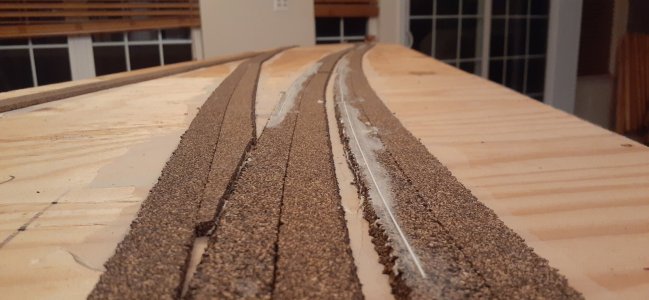You are using an out of date browser. It may not display this or other websites correctly.
You should upgrade or use an alternative browser.
You should upgrade or use an alternative browser.
HO Curves
- Thread starter jetsmell
- Start date
santafewillie
Same Ol' Buzzard
4x8 would work just fine. Use eight pieces of 22" radius curved track and that gives a bit of "fudge" room on the outside. Most engines can negotiate that radius although some might not look real good.
trailrider
Well-Known Member
Model railroad curves are generally much sharper than the prototype. Although wider curves are always desirable, Atlas Snaptrack curves come in 22, 18 and 15 inch radius sizes. Those are to the centerline of the track, so a 180-degree curve in 22-inch means a 44-inch diameter circle plus another 4 inches to the outside, with a bit of room to spare. So a 4 x 8 sheet of plywood would work, although you would probably want to have some barriers on the edges of the board to keep derailed rolling stock from "taking the high plunge". If you used 18" radius curves it would give you a little more room to spare. Fifteen-inch curves should be reserved for sharp industrial curves.
As Trainnut said, it will depend on what engines and rolling stock you want to use. Some manufacturers will specify the minimum radius their rolling stock will handle. While it is sometimes possible to run 85 ft long passenger cars or some freight cars on 18" radius curves, broader curves will make them look better. Give us a little more information on what era and what industries your railroad will serve, and we can better advise you.
Welcome to the Forum!
As Trainnut said, it will depend on what engines and rolling stock you want to use. Some manufacturers will specify the minimum radius their rolling stock will handle. While it is sometimes possible to run 85 ft long passenger cars or some freight cars on 18" radius curves, broader curves will make them look better. Give us a little more information on what era and what industries your railroad will serve, and we can better advise you.
Welcome to the Forum!
D&J RailRoad
Professor of HO
HO, I just some used track but don't know which kind. There some flexible.well what type of track are you using and what type of engines do you plan running on it?
KriegslokBR52
Well-Known Member
HO, I just some used track but don't know which kind. There some flexible.
Your question is way open, considering you don't even know what kind of railroad equipment you want to run. 18" curves are generally found in trainsets and i've learned over time not to even bother with them. Only exception would be some industrial spurs, steel mill, or lumber yards would have track curves that sharp. Ask yourself how much space you have to play with. If you have more than 4 feet available for your curves, then i would go for the broadest curves possible, you won't regret it. Operation on broader curves is easier, there's less chance of derailments and trains look a lot better on broad curves.Don't know which engine yet.
Selector
Well-Known Member
This is an unanswerable question as it stands. We don't know the room you have for a layout, what track configuration you're using, what your rolling stock is, what your minimum radius is for the most restrictive item in your rolling stock, what gauge loading you'll need (you can look that up), and what kind of playing-with-trains you like or would like to learn to like.How much plywood would I need to make a track or a bank 180 degrees. I was thinking 4x8 or is that too much.
However, to help you out, here are several big mistakes typical for newcomers to the sport...er hobby. It's really a sport at times because you have to have a thick skin and be a good sport to enjoy it, especially if you make one or more serious errors:
1. Not having the room for an adequate track plan based on your interests and rolling stock;
2. Not figuring a reach into a large layout surface to retrieve derailed items or to fix scenery;
3. Not leaving enough room to walk around the layout and to store stuff in the space you're allotted;
4. Not having enough safe distance from a broad curve that gets too close to the Drop of Death at the edge of a layout when things derail or just get knocked over by your elbow as you're trying to reach something further into the space of the layout (see how it all interrelates..?);
5. Laying curves too sharp for the lengths of engines and rolling stock. They become uncoupled or just drag each other out of the gauge...they derail. This is especially true when backing long passenger cars on tight curves. You'll forever be reaching over to rerail them because backing bunches up the couplers. If they have diaphragms, especially, you're asking for trouble on tight curvature.
6. Wanting a grade where the train passes over itself or a lower road and there is insufficient grade or insufficient overhead clearance for the train passing under, say, a bridge. If the grade exceeds about 3.3%, many locomotives will only be able to pull themselves and three or four cars, with some variance for heavier locomotives and lighter cars; and
7. Not making grade changes, from level to up, and from level to down, gradual enough that the coupler release pins don't snag or the couplers simply disengage. Not only that, but the gradual vertical curves into and out of grades eats up part of your total distance to that overhead you're trying to craft.


